Unit 5 Art world Reading课件-2024-2025学年牛津译林版英语九年级上册
文档属性
| 名称 | Unit 5 Art world Reading课件-2024-2025学年牛津译林版英语九年级上册 | 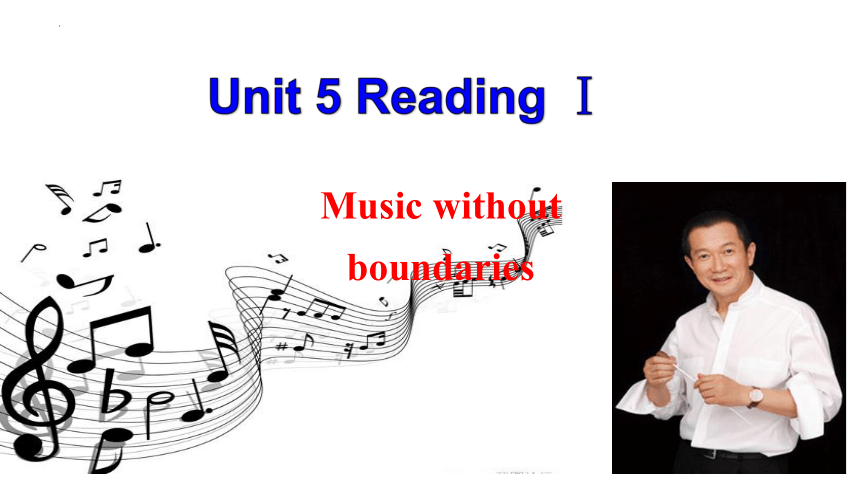 | |
| 格式 | pptx | ||
| 文件大小 | 16.6MB | ||
| 资源类型 | 试卷 | ||
| 版本资源 | 牛津译林版 | ||
| 科目 | 英语 | ||
| 更新时间 | 2024-10-19 13:45:47 | ||
图片预览

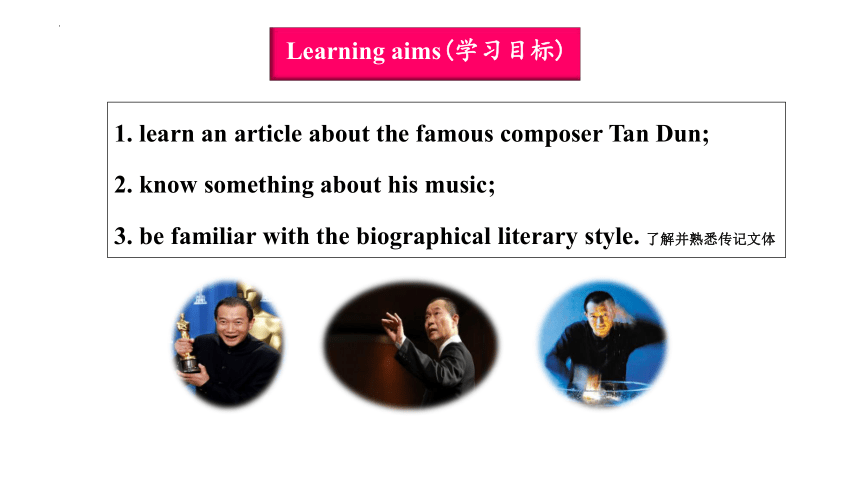



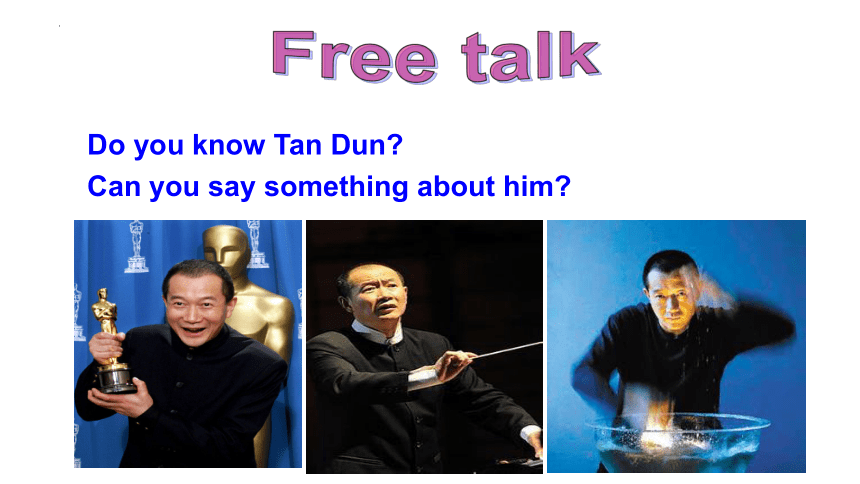
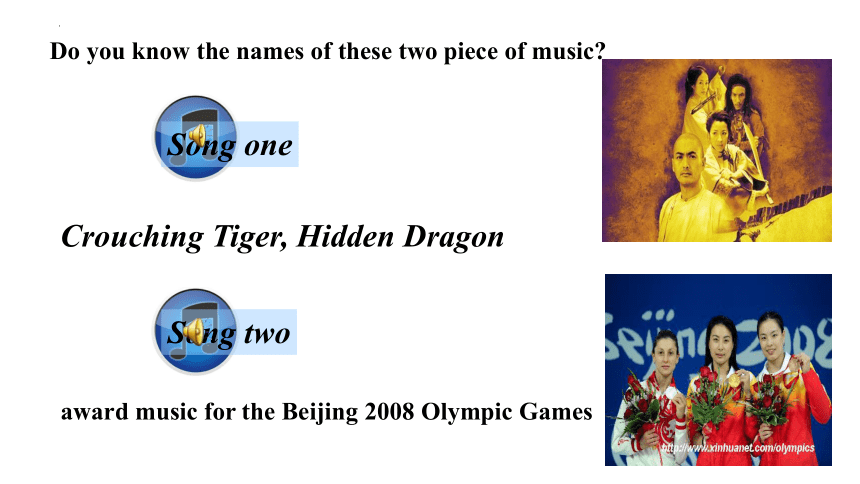

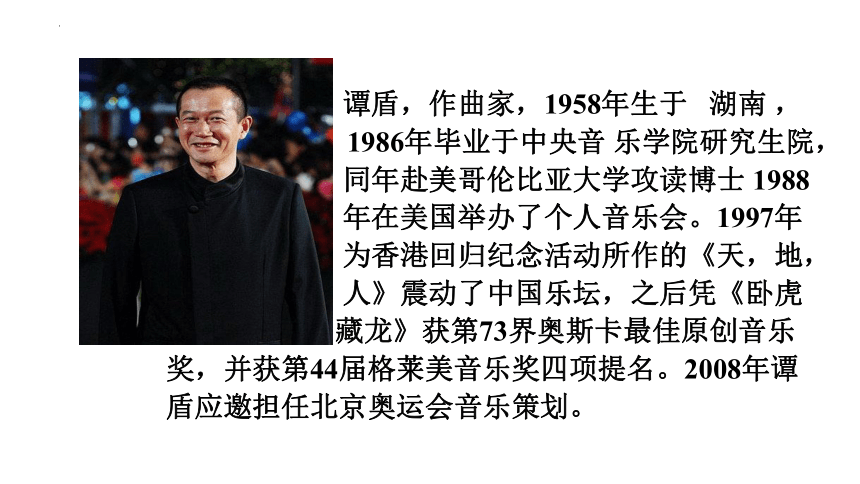
文档简介
(共28张PPT)
Music without boundaries
Unit 5 Reading Ⅰ
Learning aims(学习目标)
1. learn an article about the famous composer Tan Dun;
2. know something about his music;
3. be familiar with the biographical literary style. 了解并熟悉传记文体
Words review
boundary
medal
present
winner
composer
central
instrument
n. 边界,疆界,界限
n. 奖牌,奖章
vt. 颁发,提交
n. 获胜者
n. 作曲家
adj. 中心的,中央的
n. 乐器,工具,器械
Words review
common
object
stone
musician
control
flow
successfully
adj. 普通的,常见的
n. 物品,东西
n. 石头
n. 音乐家
vt. 控制,支配
n. 流动
adv. 成功地
Words review
traditional
bell
though
be known/famous for
dividing line
adj. 传统的
n. 钟,铃
conj. 虽然,尽管
因……而著名
n. 分界线,界限
Do you know Tan Dun
Can you say something about him
Free talk
Do you know the names of these two piece of music
Crouching Tiger, Hidden Dragon
Song one
Song two
award music for the Beijing 2008 Olympic Games
The two pieces of music you have heard above were composed by the same person---Tan Dun.
谭盾,作曲家,1958年生于 湖南 ,
1986年毕业于中央音 乐学院研究生院,
同年赴美哥伦比亚大学攻读博士 1988
年在美国举办了个人音乐会。1997年
为香港回归纪念活动所作的《天,地,
人》震动了中国乐坛,之后凭《卧虎
藏龙》获第73界奥斯卡最佳原创音乐奖,并获第44届格莱美音乐奖四项提名。2008年谭盾应邀担任北京奥运会音乐策划。
Sandy likes reading music magazines. She is reading an article about the famous composer Tan Dun. Here is the article.
A
▲
Music without boundaries
Each time a medal was presented to a winner at the Beijing 2008 Olympic Games, the award music was played. The music was written by Tan Dun, a world-famous composer.
Born in 1958 in central Hunan, China, Tan Dun grew up near the Liuyang River. When he was very young, Tan showed an interest in music. He loves the sounds of the rushing water and the blowing wind because, to him, the best music comes from nature. Since he had no musical instruments then, he made music with common objects like stones and paper.
In 1978, Tan entered the Central Conservatory of Music in Beijing. Eight years later, he went on to study in the USA. There he got to know great musicians from around the world. As a composer, perhaps he is best known for winning an Oscar for his music in the film Crouching Tiger, Hidden Dragon.
As he likes the sounds of nature, Tan uses them a lot in his music. His amazing piece of music Water does not use any musical instruments. Instead, Tan makes over 50 sounds from water by controlling the speed of water flow. "They're the sounds of nature, and they create different pictures in different minds," Tan said.
Tan has helped build a bridge between the East and the West. He has successfully brought Chinese and Western music together. The music for the Beijing Olympics uses traditional Chinese music and the sounds of an ancient Chinese bell, though it is in a Western style.
"My music is to dream without boundaries," Tan once said. In his works, the past and the present, common objects and musical instruments, traditional Chinese music and modern Western music all mix together to make a new type—music without boundaries.
1 present
2 composer
3 central
4 common
5 control
6 boundary
Sandy wants to know the meanings of some new words in the article. Help her match the words on the left with the meanings on the right. Write the correct letters in the blanks.
B1
▲
_____
_____
_____
_____
_____
_____
c
a
e
d
b
f
a a dividing line
b not special
c make something work in the way you want
d a person who writes music
e in the centre of an area
f give something to someone, especially at
an important event
Fast reading
What is each paragraph about
Tan’s education
Introduction to Tan
Tan’s childhood
Tan’s music style
Tan’s music Water
Tan’s achievements
Para 1
Para 2
Para 3
Para 4
Para 5
Para 6
Part 1
Tan’s a__________
Tan’s e__________
Tan’s w__________
Part 2
Part 4
Part 3
Tan’s i__________
xperiences
orks
chievements
introduction
Read Para. 1 and judge T or F.
1. Tan Dun wrote music for the Beijing
2008 Olympic Games.
2. Tan Dun is a world-famous actor.
composer.
T
F
Tan Dun's profile
Detailed reading
Year of birth: _______________________________
Place of birth: ______________________________
Interest: ___________________________________
The best music to him: ______________________
Instruments he used: _______________________
1958
that comes from nature
music
Central Hunan, China
common objects
Read Para. 2 and Fill in the profile card according the article.
Tan Dun's profile
the rushing water
the blowing wind
stones and paper
Read Para. 3 and find out Tan’s education experience.
1.in 1978
2.eight years later
went on to study _____________ ,
got to know great ___________from around the world.
in the USA
musicians
traditional Chinese music
modern Western music
All these things have made a good influence on Tan Dun’s later music.
studied music at a university in ________
Bejing
Tan Dun’s
Education
Read Para. 4 and fill in the table.
Tan Dun’s works
Why is Tan Dun's music special
Reason uses a lot of _________________in his music _________ musical instruments, different pictures in different minds can_________.
Example Water: _______than 50 sounds are made when the speed of water flow ______________.
sounds of nature
instead of
more
is under control
be created
Tan Dun’s achievements
Read Para. 5 and choose the right answers.
1. Tan has great influences in the world. What are they
A. He builds a bridge between the East and the West.
B. He brings Chinese and Western music together.
C. He has helped China and the USA become friends.
2. Which sentence is true about the music for the Beijing Olympics according to the text
A. It uses classical music and ancient bell.
B. It uses traditional Chinese music and a common Chinese bell.
C. It uses Chinese music to play in a Western style.
Read Para. 6 and choose the right answers.
Tan Dun’s achievements
1. What does the underlined word "mix" mean
A. 微小 B. 融合 C.思念
True or false
1. Tan's music mixes the past and the present.
2. Tan only uses common objects to make music.
3. In Tan's music, traditional Chinese music and modern Western music can mix perfectly.
4. Tan creates a new type of music—— music without boundaries.
T
F
T
T
the past
the present
common objects
musical instruments
traditional Chinese music
modern Western music
Tan Dun’s music mix a lot of things together
Sandy is making a profile card about Tan Dun. Help her fill in the card with the information on pages 66 and 67.
B2
▲
Tan Dun
Year of birth: (1)______________________
Place of birth: (2)______________________
Interest(s): (3)______________________
Job: (4)______________________
Education: studied music at a university in (5)_________________
went on to study in (6)_________________
Best known for: winning an (7)_________________ for the music in a film
His music: uses (8)___________________ a lot
builds a bridge (9)_________________________
1958
central Hunan, China
music
composer
Beijing/1978
the USA
Oscar
the sounds of nature
between the East and the West
Sandy is talking with Daniel about Tan Dun. Complete their conversation with the information on pages 66 and 67.
B3
▲
Daniel: Tan Dun is one of the greatest (1) __________ in the world.
Could you tell me more about him
Sandy: Sure. He wrote the (2) ________ music for the Beijing 2008
Olympic Games.
Daniel: I know he loves the sounds of (3) ___________. Have they
influenced his works
Sandy: Yes. He uses them a lot in his music, and in one of his works,
Water, he doesn't use any musical (4) _____________.
composers
award
nature
instruments
Daniel: Really How does he make music, then
Sandy: He makes over 50 sounds from water by (5) ___________ the
speed of water (6) ____________.
Daniel: That's really amazing!
Sandy: Yes. When he was young, he used to make music with (7)
__________ objects like stones and paper.
Daniel: Wow! His music for the Beijing Olympics must be very special!
Sandy: Yes. It uses (8) __________ Chinese music and an (9) ________
Chinese bell, but it's in a (10) _________ style.
controlling
flow
common
traditional
ancient
Western
What does Tan Dun mean by saying that “My music is to dream without boundaries” Give examples if necessary.
B4
▲
________________________________________________________
________________________________________________________
________________________________________________________
________________________________________________________
________________________________________________________
________________________________________________________
________________________________________________________
1. Review the words and expressions of Reading
2. Retell the Reading part
3. Preview the Grammar part
Music without boundaries
Unit 5 Reading Ⅰ
Learning aims(学习目标)
1. learn an article about the famous composer Tan Dun;
2. know something about his music;
3. be familiar with the biographical literary style. 了解并熟悉传记文体
Words review
boundary
medal
present
winner
composer
central
instrument
n. 边界,疆界,界限
n. 奖牌,奖章
vt. 颁发,提交
n. 获胜者
n. 作曲家
adj. 中心的,中央的
n. 乐器,工具,器械
Words review
common
object
stone
musician
control
flow
successfully
adj. 普通的,常见的
n. 物品,东西
n. 石头
n. 音乐家
vt. 控制,支配
n. 流动
adv. 成功地
Words review
traditional
bell
though
be known/famous for
dividing line
adj. 传统的
n. 钟,铃
conj. 虽然,尽管
因……而著名
n. 分界线,界限
Do you know Tan Dun
Can you say something about him
Free talk
Do you know the names of these two piece of music
Crouching Tiger, Hidden Dragon
Song one
Song two
award music for the Beijing 2008 Olympic Games
The two pieces of music you have heard above were composed by the same person---Tan Dun.
谭盾,作曲家,1958年生于 湖南 ,
1986年毕业于中央音 乐学院研究生院,
同年赴美哥伦比亚大学攻读博士 1988
年在美国举办了个人音乐会。1997年
为香港回归纪念活动所作的《天,地,
人》震动了中国乐坛,之后凭《卧虎
藏龙》获第73界奥斯卡最佳原创音乐奖,并获第44届格莱美音乐奖四项提名。2008年谭盾应邀担任北京奥运会音乐策划。
Sandy likes reading music magazines. She is reading an article about the famous composer Tan Dun. Here is the article.
A
▲
Music without boundaries
Each time a medal was presented to a winner at the Beijing 2008 Olympic Games, the award music was played. The music was written by Tan Dun, a world-famous composer.
Born in 1958 in central Hunan, China, Tan Dun grew up near the Liuyang River. When he was very young, Tan showed an interest in music. He loves the sounds of the rushing water and the blowing wind because, to him, the best music comes from nature. Since he had no musical instruments then, he made music with common objects like stones and paper.
In 1978, Tan entered the Central Conservatory of Music in Beijing. Eight years later, he went on to study in the USA. There he got to know great musicians from around the world. As a composer, perhaps he is best known for winning an Oscar for his music in the film Crouching Tiger, Hidden Dragon.
As he likes the sounds of nature, Tan uses them a lot in his music. His amazing piece of music Water does not use any musical instruments. Instead, Tan makes over 50 sounds from water by controlling the speed of water flow. "They're the sounds of nature, and they create different pictures in different minds," Tan said.
Tan has helped build a bridge between the East and the West. He has successfully brought Chinese and Western music together. The music for the Beijing Olympics uses traditional Chinese music and the sounds of an ancient Chinese bell, though it is in a Western style.
"My music is to dream without boundaries," Tan once said. In his works, the past and the present, common objects and musical instruments, traditional Chinese music and modern Western music all mix together to make a new type—music without boundaries.
1 present
2 composer
3 central
4 common
5 control
6 boundary
Sandy wants to know the meanings of some new words in the article. Help her match the words on the left with the meanings on the right. Write the correct letters in the blanks.
B1
▲
_____
_____
_____
_____
_____
_____
c
a
e
d
b
f
a a dividing line
b not special
c make something work in the way you want
d a person who writes music
e in the centre of an area
f give something to someone, especially at
an important event
Fast reading
What is each paragraph about
Tan’s education
Introduction to Tan
Tan’s childhood
Tan’s music style
Tan’s music Water
Tan’s achievements
Para 1
Para 2
Para 3
Para 4
Para 5
Para 6
Part 1
Tan’s a__________
Tan’s e__________
Tan’s w__________
Part 2
Part 4
Part 3
Tan’s i__________
xperiences
orks
chievements
introduction
Read Para. 1 and judge T or F.
1. Tan Dun wrote music for the Beijing
2008 Olympic Games.
2. Tan Dun is a world-famous actor.
composer.
T
F
Tan Dun's profile
Detailed reading
Year of birth: _______________________________
Place of birth: ______________________________
Interest: ___________________________________
The best music to him: ______________________
Instruments he used: _______________________
1958
that comes from nature
music
Central Hunan, China
common objects
Read Para. 2 and Fill in the profile card according the article.
Tan Dun's profile
the rushing water
the blowing wind
stones and paper
Read Para. 3 and find out Tan’s education experience.
1.in 1978
2.eight years later
went on to study _____________ ,
got to know great ___________from around the world.
in the USA
musicians
traditional Chinese music
modern Western music
All these things have made a good influence on Tan Dun’s later music.
studied music at a university in ________
Bejing
Tan Dun’s
Education
Read Para. 4 and fill in the table.
Tan Dun’s works
Why is Tan Dun's music special
Reason uses a lot of _________________in his music _________ musical instruments, different pictures in different minds can_________.
Example Water: _______than 50 sounds are made when the speed of water flow ______________.
sounds of nature
instead of
more
is under control
be created
Tan Dun’s achievements
Read Para. 5 and choose the right answers.
1. Tan has great influences in the world. What are they
A. He builds a bridge between the East and the West.
B. He brings Chinese and Western music together.
C. He has helped China and the USA become friends.
2. Which sentence is true about the music for the Beijing Olympics according to the text
A. It uses classical music and ancient bell.
B. It uses traditional Chinese music and a common Chinese bell.
C. It uses Chinese music to play in a Western style.
Read Para. 6 and choose the right answers.
Tan Dun’s achievements
1. What does the underlined word "mix" mean
A. 微小 B. 融合 C.思念
True or false
1. Tan's music mixes the past and the present.
2. Tan only uses common objects to make music.
3. In Tan's music, traditional Chinese music and modern Western music can mix perfectly.
4. Tan creates a new type of music—— music without boundaries.
T
F
T
T
the past
the present
common objects
musical instruments
traditional Chinese music
modern Western music
Tan Dun’s music mix a lot of things together
Sandy is making a profile card about Tan Dun. Help her fill in the card with the information on pages 66 and 67.
B2
▲
Tan Dun
Year of birth: (1)______________________
Place of birth: (2)______________________
Interest(s): (3)______________________
Job: (4)______________________
Education: studied music at a university in (5)_________________
went on to study in (6)_________________
Best known for: winning an (7)_________________ for the music in a film
His music: uses (8)___________________ a lot
builds a bridge (9)_________________________
1958
central Hunan, China
music
composer
Beijing/1978
the USA
Oscar
the sounds of nature
between the East and the West
Sandy is talking with Daniel about Tan Dun. Complete their conversation with the information on pages 66 and 67.
B3
▲
Daniel: Tan Dun is one of the greatest (1) __________ in the world.
Could you tell me more about him
Sandy: Sure. He wrote the (2) ________ music for the Beijing 2008
Olympic Games.
Daniel: I know he loves the sounds of (3) ___________. Have they
influenced his works
Sandy: Yes. He uses them a lot in his music, and in one of his works,
Water, he doesn't use any musical (4) _____________.
composers
award
nature
instruments
Daniel: Really How does he make music, then
Sandy: He makes over 50 sounds from water by (5) ___________ the
speed of water (6) ____________.
Daniel: That's really amazing!
Sandy: Yes. When he was young, he used to make music with (7)
__________ objects like stones and paper.
Daniel: Wow! His music for the Beijing Olympics must be very special!
Sandy: Yes. It uses (8) __________ Chinese music and an (9) ________
Chinese bell, but it's in a (10) _________ style.
controlling
flow
common
traditional
ancient
Western
What does Tan Dun mean by saying that “My music is to dream without boundaries” Give examples if necessary.
B4
▲
________________________________________________________
________________________________________________________
________________________________________________________
________________________________________________________
________________________________________________________
________________________________________________________
________________________________________________________
1. Review the words and expressions of Reading
2. Retell the Reading part
3. Preview the Grammar part
